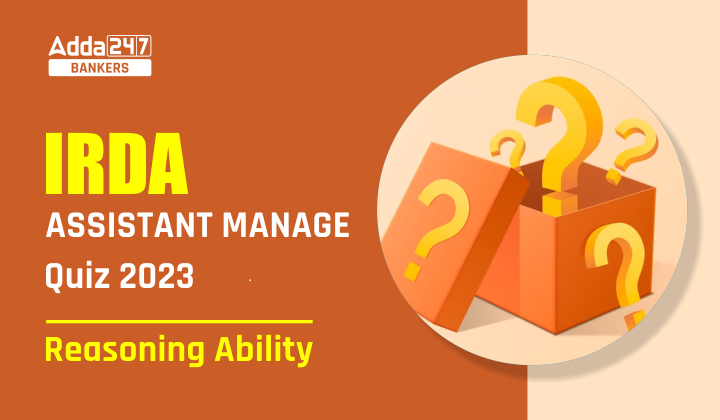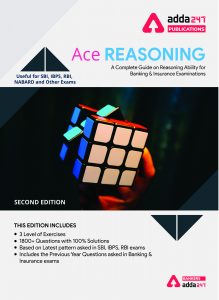Directions (1-5): In these questions, a relationship between different elements is shown in the statements. The statements are followed by two conclusions. Give answer
Q1. Statement: A > B; G < D ≤ E; G ≥ F > B
Conclusion: I. G ≥ A II. B < E
(a) if only conclusion II is true.
(b) if only conclusion I is true.
(c) if neither conclusion I nor II is true.
(d) if either conclusion I or II is true.
(e) if both conclusions I and II are true.
Q2. Statement: A > T ≥ J; A ≤ S = H; I > T
Conclusion: I. H > J II. I > S
(a) if both conclusion I and II are true.
(b) if only conclusion I is true.
(c) if neither conclusion I nor II is true.
(d) if either conclusion I or II is true.
(e) if only conclusion II is true.
Q3. Statement: J ≥ K > L < M ≥ N; K ≥ O = T
Conclusion: I. J > O II. J = T
(a) if only conclusion II is true.
(b) if either conclusion I or II is true.
(c) if neither conclusion I nor II is true.
(d) if only conclusion I is true.
(e) if both conclusions I and II are true.
Q4. Statement: A > T = N; A > S > R; A < M
Conclusion: I. R < T II. N ≤ R
(a) if only conclusion II is true.
(b) if only conclusion I is true.
(c) if neither conclusion I nor II is true.
(d) if either conclusion I or II is true.
(e) if both conclusions I and II are true.
Q5. Statement: A < B ≤ C; F < M ≤ C; C > Q
Conclusion: I. Q ≤ F II. F > Q
(a) if only conclusion II is true.
(b) if either conclusion I or II is true.
(c) if neither conclusion I nor II is true.
(d) if only conclusion I is true.
(e) if both conclusions I and II are true.
Direction (6-10): In the following questions assuming the given statement to be true, find which of the conclusion(s) among given conclusions is/are definitely true and then give your answers accordingly.
Q6. Statements: Q ≤ W ≤ G, C > U > G > O > V
Conclusions: I. U > W II. C > Q
(a) Only I is true
(b) Only II is true
(c) Either I or II is true
(d) Neither I nor II is true
(e) Both I and II are true
Q7. Statements: D > H > T, W ≥ P ≥ H < I
Conclusions: I. W < T II. T < I
(a) Only I is true
(b) Only II is true
(c) Either I or II is true
(d) Neither I nor II is true
(e) Both I and II are true
Q8. Statements: U < P < Y, J ≥ F > E, S = U ≥ E
Conclusions: I. J ≤ Y II. E < P
(a) Only I is true
(b) Only II is true
(c) Either I or II is true
(d) Neither I nor II is true
(e) Both I and II are true
Q9. Statements: T > A ≥ G, G = U > E, T ≥ F
Conclusions: I. T > U II. T = U
(a) Only I is true
(b) Only II is true
(c) Either I or II is true
(d) Neither I nor II is true
(e) Both I and II are true
Q10. Statements: J > A ≥ K, K = U > E, J ≥ F > L
Conclusions: I. J > L II. K < L
(a) Only I is true
(b) Only II is true
(c) Either I or II is true
(d) Neither I nor II is true
(e) Both I and II are true
Direction (11-15): In the following questions assuming the given statement to be true, find which of the conclusion(s) among given conclusions is/are definitely true and then give your answers accordingly.
Q11. Statements: D = E ≤ S, A = L ≤ C ≤ D, S ≥ G > H
Conclusions: I. L < S
II. L = S
(a) Only I is true
(b) Only II is true
(c) Either I or II is true
(d) Neither I nor II is true
(e) Both I and II are true
Q12. Statements: R ≤ O = U ≥ Y, P = Q = R, Y = W > X
Conclusions: I. Q < U
II. Q = U
(a) Only I is true
(b) Only II is true
(c) Either I or II is true
(d) Neither I nor II is true
(e) Both I and II are true
Q13. Statements: B ≥ P < H ≤ C, D > E = B, C < J > K ≥ L
Conclusions: I. P < J
II. E ≥ C
(a) Only I is true
(b) Only II is true
(c) Either I or II is true
(d) Neither I nor II is true
(e) Both I and II are true
Q14. Statements: V < X, T = O, X ≤ P, O ≥ V > S = H
Conclusions: I. T > S
II. V > P
(a) Only I is true
(b) Only II is true
(c) Either I or II is true
(d) Neither I nor II is true
(e) Both I and II are true
Q15. Statements: Q = W > D, E ≤ F, C < W, C ≤ F
Conclusions: I. C > D
II. F > Q
(a) Only I is true
(b) Only II is true
(c) Either I or II is true
(d) Neither I nor II is true
(e) Both I and II are true
Solutions
Solutions (1-5):
S1. Ans.(a)
Sol. I. G ≥ A (False) II. B < E (True)
S2. Ans.(b)
Sol. I. H > J (True) II. I > S (False)
S3. Ans.(b)
Sol. I. J > O (False) II. J = T (False)
S4. Ans.(d)
Sol. I. R < T (False) II. N ≤ R (False)
S5. Ans.(c)
Sol. I. Q ≤ F (False) II. F > Q (False)
Solution (6-10):
S6. Ans. (e)
Sol. I. U > W – True
II. C > Q – True
S7. Ans. (b)
Sol. I. W < T – False
II. T < I – True
S8. Ans. (b)
Sol. I. J ≤ Y – False
II. E < P – True
S9. Ans. (a)
Sol. I. T > U – True
II. T = U – False
S10. Ans. (a)
Sol. I. J > L – True
II. K < L – False
Solution (11-15):
S11. Ans. (c)
Sol. I. L < S – False
II. L = S – False
S12. Ans. (c)
Sol. I. Q < U – False
II. Q = U – False
S13. Ans. (a)
Sol. I. P < J – True
II. E ≥ C – False
S14. Ans. (a)
Sol. I. T > S – True
II. V > P – False
S15. Ans. (d)
Sol. I. C > D – False
II. F > Q – False





 GA Capsule for SBI Clerk Mains 2025, Dow...
GA Capsule for SBI Clerk Mains 2025, Dow...
 The Hindu Review October 2022: Download ...
The Hindu Review October 2022: Download ...
 IBPS PO Apply Online 2025, Online Applic...
IBPS PO Apply Online 2025, Online Applic...


